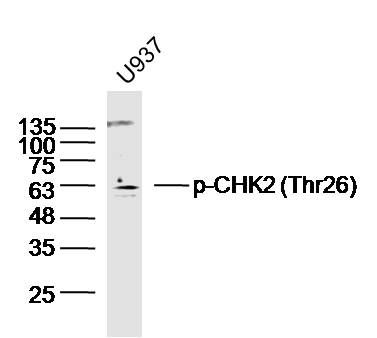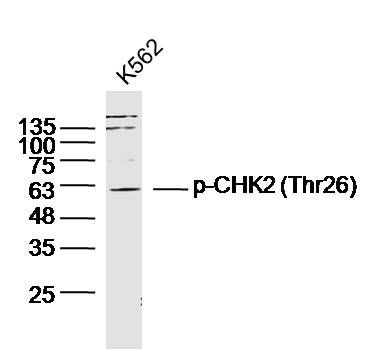产品中心
当前位置:首页>产品中心Anti-Phospho-CHK2 (Thr26)
货号: bs-13909R 基本售价: 1580.0 元 规格: 100ul
产品信息
- 产品编号
- bs-13909R
- 英文名称
- Phospho-CHK2 (Thr26)
- 中文名称
- 磷酸化细胞周期检测点激酶2抗体
- 别 名
- Chk2 (phospho T26); p-Chk2 (phospho T26); bA444G7; CHK2 checkpoint homolog; CHK2_HUMAN; Serine/threonine-protein kinase Chk2; CDS 1; CDS1; Checkpoint kinase 2; Checkpoint like protein CHK2; Chek 2; Chek2; Chk 2; CHK2 checkpoint homolog (S. pombe); CHK2 checkpoint homolog; HuCds 1; HuCds1; LFS 2; LFS2; PP1425; RAD 53; RAD53; Rad53 homolog; Serine/threonine protein kinase Chk2.
- 规格价格
- 100ul/1580元购买 大包装/询价
- 说 明 书
- 100ul
- 产品类型
- 磷酸化抗体
- 研究领域
- 肿瘤 细胞生物 信号转导 表观遗传学
- 抗体来源
- Rabbit
- 克隆类型
- Polyclonal
- 交叉反应
- Human,
- 产品应用
- WB=1:500-2000 ELISA=1:500-1000 IHC-F=1:400-800 ICC=1:100-500 IF=1:100-500 (石蜡切片需做抗原修复)
not yet tested in other applications.
optimal dilutions/concentrations should be determined by the end user.
- 分 子 量
- 61kDa
- 细胞定位
- 细胞核
- 性 状
- Lyophilized or Liquid
- 浓 度
- 1mg/ml
- 免 疫 原
- KLH conjugated Synthesised phosphopeptide derived from human CHK2 around the phosphorylation site of Thr26:SV(p-T)Q
- 亚 型
- IgG
- 纯化方法
- affinity purified by Protein A
- 储 存 液
- 0.01M TBS(pH7.4) with 1% BSA, 0.03% Proclin300 and 50% Glycerol.
- 保存条件
- Store at -20 °C for one year. Avoid repeated freeze/thaw cycles. The lyophilized antibody is stable at room temperature for at least one month and for greater than a year when kept at -20°C. When reconstituted in sterile pH 7.4 0.01M PBS or diluent of antibody the antibody is stable for at least two weeks at 2-4 °C.
- PubMed
- PubMed
- 产品介绍
- background:
Chk2 is a serine/threonine kinase involved in the control of cell cycle checkpoints, and may also participate in transduction of the DNA damage and replicational stress signals. Chk2 is the mammalian ortholog of the budding yeast Rad53 and fission yeast Cds1 checkpoint kinases. The amino-terminal domain of Chk2 contains a series of seven serine and threonine residues (Ser19, Thr26, Ser28, Ser33, Ser35, Ser50 and Thr68) followed by glutamine (SQ or TQ motif). These are known to be preferred sites for phosphorylation by ATM/ATR kinases. Indeed, after DNA damage by ionizing radiation (IR), UV irradiation or hydroxyurea treatment, Thr68 and other sites in this region become phosphorylated by ATM/ATR. The SQ/TQ cluster domain, therefore, seems to have a regulatory function. Phosphorylation at Thr68 is a prerequisite for the subsequent activation step, which is attributable to autophosphorylation of Chk2 on residues Thr383 and Thr387 in the activation loop of the kinase domain. Chk2 inhibits CDC25C phosphatase by phosphorylating it on Ser-216, preventing the entry into mitosis. This kinase may have a role in meiosis as well. Kinase activity is up regulated by autophosphorylation and the protein is rapidly phosphorylated in response to DNA damage and to replication block.
Function:
Regulates cell cycle checkpoints and apoptosis in response to DNA damage, particularly to DNA double-strand breaks. Inhibits CDC25C phosphatase by phosphorylation on Ser-216, preventing the entry into mitosis. May also play a role in meiosis. Regulates the TP53 tumor suppressor through phosphorylation at Thr-18 and Ser-20.
Subunit:
Homodimer. Homodimerization is part of the activation process but the dimer may dissociate following activation. Interacts with PML. Interacts with TP53. Interacts with RB1; phosphorylates RB1. Interacts with BRCA1. Interacts (phosphorylated at Thr-68) with MDC1; requires ATM-mediated phosphorylation of CHEK2. Interacts with TP53BP1; modulates CHEK2 phosphorylation at Thr-68 in response to ionizing radiation. Interacts with CDC25A; phosphorylates CDC25A and mediates its degradation in response to ionizing radiation. Interacts with CUL1; mediates CHEK2 ubiquitination and regulation.
Subcellular Location:
Nucleus; Nucleus. Isoform 10 is present throughout the cell and Nucleus > PML body. Nucleus > nucleoplasm. Recruited into PML bodies together with TP53.
Tissue Specificity:
High expression is found in testis, spleen, colon and peripheral blood leukocytes. Low expression is found in other tissues.
Post-translational modifications:
Phosphorylated by PLK4.
DISEASE:
Defects in CHEK2 are associated with Li-Fraumeni syndrome 2 (LFS2) [MIM:609265]; a highly penetrant familial cancer phenotype usually associated with inherited mutations in p53/TP53.
Defects in CHEK2 may be a cause of susceptibility to prostate cancer (PC) [MIM:176807]. It is a malignancy originating in tissues of the prostate. Most prostate cancers are adenocarcinomas that develop in the acini of the prostatic ducts. Other rare histopathologic types of prostate cancer that occur in approximately 5% of patients include small cell carcinoma, mucinous carcinoma, prostatic ductal carcinoma, transitional cell carcinoma, squamous cell carcinoma, basal cell carcinoma, adenoid cystic carcinoma (basaloid), signet-ring cell carcinoma and neuroendocrine carcinoma.
Defects in CHEK2 are found in some patients with osteogenic sarcoma (OSRC) [MIM:259500].
Similarity:
Belongs to the protein kinase superfamily.
CAMK Ser/Thr protein kinase family.
CHK2 subfamily.
Contains 1 FHA domain.Contains 1 protein kinase domain.
SWISS:
O96017
Gene ID:
11200
Database links:Entrez Gene: 11200Human
Omim: 604373Human
SwissProt: O96017Human
Unigene: 291363Human
Unigene: 505297Human
Important Note:
This product as supplied is intended for research use only, not for use in human, therapeutic or diagnostic applications.
- 产品图片
 Sample: U937(Human) Cell Lysate at 40 ug
Sample: U937(Human) Cell Lysate at 40 ug
Primary: Anti-p-CHK2 (Thr26)(bs-13909R)at 1/300 dilution
Secondary: IRDye800CW Goat Anti-RabbitIgG at 1/20000 dilution
Predicted band size: 61kD
Observed band size: 61kD Sample: K562 (Human)Cell Lysate at 40 ug
Sample: K562 (Human)Cell Lysate at 40 ug
Primary: Anti-p-CHK2 (Thr26)(bs-13909R)at 1/300 dilution
Secondary: IRDye800CW Goat Anti-RabbitIgG at 1/20000 dilution
Predicted band size: 61kD
Observed band size: 61kD

